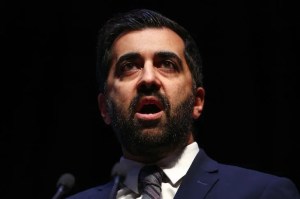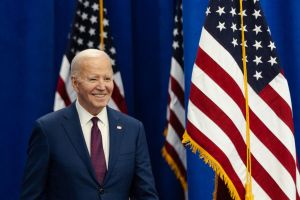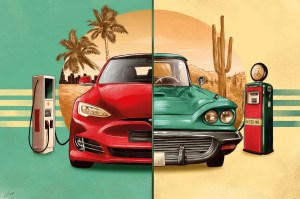Lies come in all shapes and sizes, colors, odors, textures and tastes. Some are only little white lies, but more often the accompanying adjective suggests something unpleasant. Damnable lies used to be the most condemned, but today the foulest of all perfidious, incarnadine, silken and sulfurous lies are Big Lies.
Thus when New York Times columnist Michelle Goldberg wants to reassure progressive voters that they can ignore the story about a ninth-grade girl who was raped (i.e. forcibly sodomized) in a girl’s restroom in a Loudoun County, Virginia school, she serves up her diversion under the title “The Right’s Big Lie About a Sexual Assault in Virginia.”
Among the attractions of calling what happened in Virginia “the Big Lie” is that Times readers know the term so well. Times writers used it tirelessly during and after the Trump years. A year ago, before the election, Times columnist Paul Krugman served up “The War on Truth Reaches Its Climax: Trump is telling two big lies, and a third will come soon.” Per Krugman, “The first big lie is the claim that America is being menaced by hordes of ‘rioters, looters, arsonists, gun-grabbers, flag-burners, Marxists.’” The other Big Lie, Krugman nominates, was Trump’s “dismissal of the pandemic threat, his mocking of precautionary measures like mask-wearing,” actions which, Krugman explained, “have done a lot to help the coronavirus spread.”
Krugman’s attribution of “Big Lies” to Trump is only one of hundreds — perhaps thousands — of such stories and opinion pieces in the Times over the last several years to deploy this conceit. But since the 2020 election, the Times has reveled in calling any claim about the integrity of the president vote “the Big Lie.” “The Art of the Lie? The Bigger the Better” by Andrew Higgins, January 10, 2021, exemplifies the genre, but hardly a day goes by that the Times doesn’t remind readers that any doubts about 2020 election integrity are the pillow-stuffing of the Big Lie.
The Times also takes the trouble, now and then, to recapitulate the underlying concept: make your lie big enough and sufficiently beyond the realm of credibility, and a substantial number of really gullible people will believe it, i.e. people who do not rely on the NYT to judge the accuracy of a claim.
Let me leave the Michelle Goldberg story hanging just a little longer. The “Big Lie” is such a big part of NYT rhetoric — and beyond the NYT itself, such a big part of progressive denunciation of ideas that lie outside the charmed circle of wokeness — that it is useful to go back to the origins of the concept. You can skip the next paragraph if you prefer to avoid close encounters of the Third Reich kind.
The concept of the Big Lie is often attributed to Nazi propagandist Joseph Goebbels, but more correctly it was his boss, Adolf Hitler, who coined the term. For 22 years I’ve had a copy of an English translation Mein Kampf (1925) buried unread on the bottom shelf of a bookcase beneath the stairs in my basement, visited mainly by spiders, waiting for the day when it might come in handy. Here it is on page 231, as Mr Hitler blames “the Jews and their Marxist fighting organization” for spreading the lie that Germany lost the Great War because General Erich Ludendorff had mismanaged the military. “By branding Ludendorff as guilty…they took the weapon of moral right” from Ludendorff who could otherwise have answered “the traitors to the fatherland.” Hitler saw this a preposterous invention, but note that “the magnitude of a lie always contains a certain factor of credibility,” because it corrupts “the primitive simplicity” of people’s minds. And here it is: “They more easily fall a victim to a big lie than a little one, since they themselves lie in little things, but would be ashamed of lies that were too big.” And, “something of even the most insolent lie will always remain and stick — a fact which all the great lie-virtuosi and lying-clubs in this world know only too well and also make the most treacherous use of.”
The Big Lie in other words is an outrageously false concoction put forward to advance an outrageously immoral purpose, aiming to sideline those who know the truth and seduce naive people. For instance, if one were intent on manipulating election rules in order to secure an illicit victory, it might be useful to characterize anyone who pointed out evidence of such manipulation as a dangerous liar. Perhaps one of the best ways to promulgate a “Big Lie” is to accuse your opponent of it. In any case, calling something a Big Lie but backing up the accusation with a collection of quibbles suggests that the term has lost its gravity. It floats away on the breeze like a red balloon. Which brings us back to Michelle Goldberg.
By her account, Scott Smith, a plumber and the father of the girl in Loudoun, was arrested at the school board meeting because he was “swearing loudly” and leaning towards another parent “with a clenched fist.” Goldberg allows that he was upset but, she says, Smith was really angry about “a proposed policy allowing trans kids to use bathrooms aligned with their gender identities.”
One might of thought that Smith was angry that his daughter was raped and that the school supposedly covered it up. The trans policy amplified his anger because it appeared to him (correctly) that the school prioritized getting right with the transgender movement over the safety of girls.
And thanks to Tucker Carlson, who interviewed him, Smith is now seen as “a blue-collar martyr to wokeness.” If you are waiting for the reveal in which we learn how the “Big Lie” comes into Goldberg’s story after the headline, be patient. It arrives at the end of the twentieth and last paragraph of Goldberg’s column, and even then with a different adjective: “A sad and complicated truth is probably no match for an exquisitely useful lie.”
Just what that supposed “exquisitely useful lie” is requires attentive reading. Smith’s daughter was indeed raped; Smith was indeed upset; the school authorities lied about it; the members of the school board knew the facts and also lied about them; the perpetrator (now convicted) did indeed wear a skirt; the boy indeed was transferred to another school where he committed another sexual assault; the school board was indeed preparing to announce a new “transgender policy during Pride month.”
Pretty much all of the widely reported details are exactly as they have emerged in recent weeks. So where in this story does Goldberg find “the Big Lie?”
It is a bit hard to say. Goldberg seems to find it in the widely reported fact that the girl and boy had twice previously engaged in consensual sex, and that the rape was part of an assignation gone wrong. In that sense, the boy in girl’s clothing who committed the rape was not taking advantage of a policy that allows transgender students to use the bathrooms of the sex they are pretending to belong to. That’s it. By implication, transgenderism isn’t rightly part of the story.
But do these details change the story in any meaningful way? Do they give us a “sad and complicated truth” or just the dreary reality of children who continue to be victimized by the sexualized culture that the Times generally champions? Transgenderism is simply the latest front on the left’s ever-expanding definition of sexual freedom. It evokes for some the libidinous thrill of a new kind of transgression against civilized norms. So to those of the NYT worldview, it must be a good thing.
But Goldberg probably wouldn’t have written the article were she not also concerned with the way in which this case has excited support for Republican gubernatorial candidate Glenn Youngkin and depressed the chances of Democratic candidate Terry McAuliffe. She observes that Youngkin has “sought to harness parental anger toward school boards accused of putting left-wing dogma above student welfare.”
Putting some blame on the girl and suggesting that transgenderism isn’t really part of what happened is Goldberg’s way of reframing the story to minimize the quotient of left-wing politics that has come into sharp focus for many Virginia voters. The trouble is that the school authorities and the school board plainly did act on left-wing dogma when they sought to hide what happened and then lied about their cover-up. Behind their actions was their determination to protect and advance the idea that “transgenderism” is a positive option for the students in their charge.
Big Lies apparently aren’t as a big as they once were. In fact quite a few of the ideas that now are nominated as “Big Lies” are just awkward facts. There are, of course, Big Lies aplenty if you care to take notice of the left’s shibboleths ranging from pseudo-scientific claims huddled under the banner “Trust the Science!” to pseudo-historical claims about the origin of America and the persistence of racial oppression.
But we can’t deal with everything at once. Right now we should drink some tea and enjoy the irony that the nation’s “newspaper of record” has found its guiding conceit in the writings of the twentieth century’s most notorious madman.


















